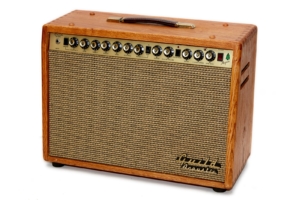
Read along while I go over every detail of this cool acoustic amp from 1993 or maybe 1994 as well as why I can’t seem to pin that date down.
Intro
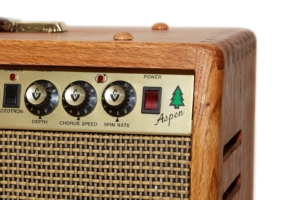
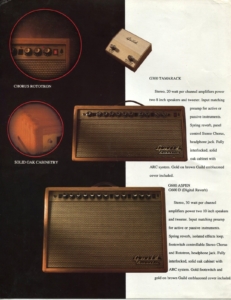
As an added thrill (for me at least) after writing about the Timberline and G300 amps, I was contacted by the person responsible for designing them. Kevin Nelson who now owns and runs Gizmoe Amps worked for Randall at the time that Guild was bought by US Music and so was the key person who designed and developed these amps. Special thanks to Kevin for answering my many questions. For those of you who’ve read many of my Guild articles, Kevin is also the person who helped me regarding the 1990s Guild Brian May pedal.
If you read my review of the Guild G300 Acoustic Amplifier, the Aspen in this article may seem like a larger version of that, though it differs in some interesting and useful ways, the most obvious being that it has larger speakers and more power. The fact that the Aspen is a larger amp also lends itself to having more expansion options such as the ability to connect to an external cabinet.
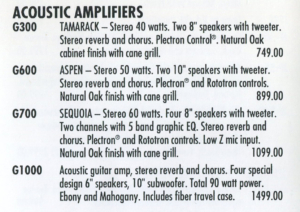
Features
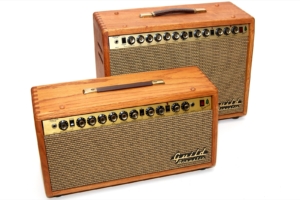
I found the manual for this amplifier on Randall’s archive page, and kudos to Randall for keeping all that old material available. Click on the image of the manual to the right to get a local copy in PDF format. The manual explains what the many knobs do which I’ll cover in detail below in the controls section.
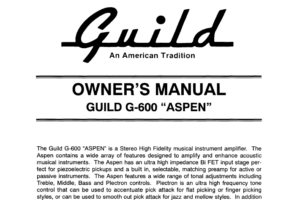
At almost twice the size of the G300 Tamarack, this amp puts out more power, has more flexibility, and looks more like a regular guitar amp. Just based on looks alone I think the average player would choose the Aspen over the Tamarack, though some of us are just obsessive about needing complete sets of things even if we don’t really have the room for them.
Cabinet and Grill
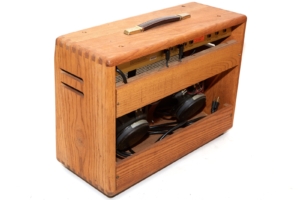
By the way, as per the designer, those slots on the side of the cabinet are not heat vents, but are there to further enhance the stereo effect of the Rototron. Oh, and you may notice that my amp has little wooden plugs covering the screw holes on the top. I added those – the amp does not come with them.
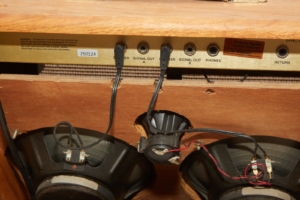
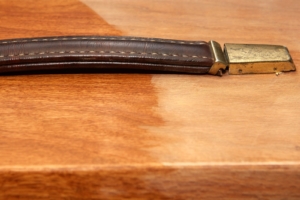
If you have one of these amps and you don’t know how to take care of the wood, rub it down with some lemon oil. You don’t need to sand it or do any of the crazy stuff I do – just give the wood some lemon oil and it will look tons better in no time. Hell, lemon oil-based furniture polish would be a fine choice too. Anything is better than letting the wood just dry out. My Aspen was so dried out that I had to treat it again after a couple of weeks.
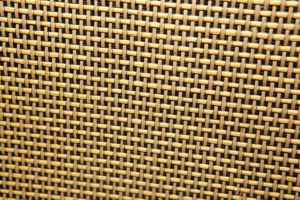
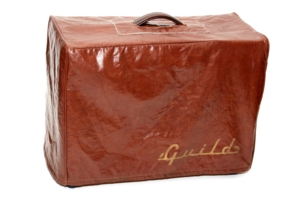
Controls
The knobs on this amp are Guild G-shield knobs in gold which are pretty damn hard to find in 2019. It is very common for these knobs to have the gold foil label fall out and sure enough this amp arrived to me with three of them missing. Since Guild does not currently sell a guitar with these knobs, they don’t sell replacement knobs in gold which means I had to resort to paying too much for them on eBay, and let me tell you: I am not a fan of paying too much for things. If you find one of these that’s broken you could buy it for cheap and flip the knobs for a likely profit. Better yet, sell it to me and let me fix the amp!
Oh, and as per the designer, the knobs are all situated so that the G-shield is right-side up when the knobs are set to zero. Why? Because marketing wanted it that way. In my pics they’re all right-side up with the knobs at five. Why? Because I wanted it that way.
Here are the front panel controls from left to right:
Input
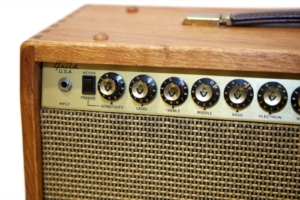
Active/Passive (switch)
If you set this to Passive and you have an active pickup in your guitar then you’ll end up pre-amping your pre-amp and it will either a) sound really bad or b) squeal and feedback like crazy which depending on your tastes may or may not be the same as (a).
Sensitivity
The sensitivity knob is only active when the Active/Passive switch is set to Passive and acts like the volume knob on an active pickup which is kind of what it is. Tip: if your guitar squeals when you turn this up, flick the Active/Passive switch to Active and stop using this knob. Also read the part that explains the Active/Passive switch again.
Note that the position of the Active/Passive switch and the Sensitivity knob are reversed on this amp when compared to the Tamarack. I doubt that will affect anyone who doesn’t own both, but I figured I’d point it out because I own both. Not even the mighty Grot can say that!
Level
The manual states that this sets the input level of the amplifier. Looking at the schematic, this control alters the gain of an opamp, so it’s like setting the volume of the preamp after the preamp that may or may not be engaged with the Active/Passive switch. Try not to think about it. This knob makes things louder.
Treble, Middle, and Bass
These are the tone controls. This is an amplified stage (they all are, really), but not individually. In other words, these are passive tone controls.
Plectron
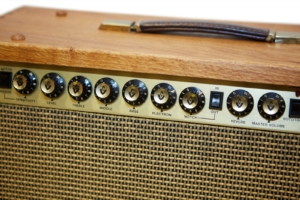
This is a standalone control that’s later in the signal chain (near the master volume), and it looks to be a simple tone control but there’s some stuff going on in that part of the schematic that exceed my self-taught capability to understand. Therefore, it’s magic until someone convinces me otherwise.
Notch
The Notch filter is used to narrowly filter out frequencies in order to help prevent feedback. This dial controls the frequency that is being filtered out, and in theory if you’re having feedback issues, turn on the Notch filter and turn this knob until it stops. The Notch filter only sweeps between 100 Hz and 1200 Hz and should have a minimal affect on tone since the filter is so narrow.
In/Out (switch)
The In/Out switch enables or disables the Notch filter.
Reverb
This dial controls the amount of reverb added to the signal. To disable it just dial it down to zero or use the foot switch. As with most tank-based reverbs, a little goes a long way and setting this too high can make the amp sound unpleasant in a “please turn the reverb down” kind of way, though I must say that I like the reverb on this amp better than I did on the G300 Tamarack which is odd because they appear to be the same circuit and tank.
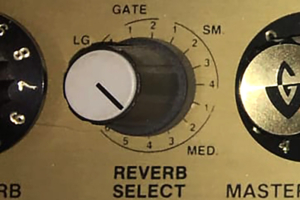
Master Volume
Rototron/Chorus (switch)
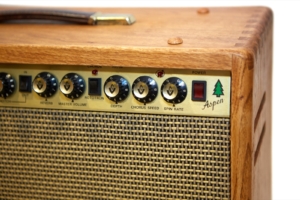
To further add to the confusion, the LED indicator above this switch has nothing to do with this switch at all. It’s actually tied to the Depth knob. Sort of.
Depth
The Depth knob controls the intensity of the Chorus and “stereo enhancement effects” as well as the Rototron depending on the previous switch setting. From what I’ve seen playing with this amp, this effect can go from subtle to “OMG turn that off!” in very short order. A little chorus goes a long way, especially with this solid state Chorus from the early ’90s.
On the G300 Tamarack that was the end of the story, but on the G600 Aspen, the Depth knob is actually a push-pull control and you pull this knob out to enable the Chorus/Rototron effect (You choose which one with the Rototron/Chorus switch). Of course I had no idea this was the case until I read the manual, but again the face plate is labeled way up high where you’ll never see it unless you tilt the amp back pretty much so its horizontal on the floor. That label says, “Pull On”. Brilliant. I’m SO glad that Randall kept those manuals online!
When using a footswitch this knob must be pushed in.
Chorus Speed
The Chorus Speed knob controls the speed of the Chorus effect as it wavers from side to side. This is another control where I tend to keep it down low because it quickly gets out of hand. This control is only active on Chorus and has no effect on the Rototron.
LED
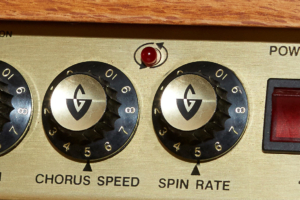
Spin Rate
Since the Rototron is supposed to simulate a spinning speaker, this knob controls the rate of the “spin” which is essentially the effect moving from side to side.
Power
Used to turn the damn thing off when your wife says it’s too loud at 11pm. You know, or the gig is over. Whatever.
Control Summary
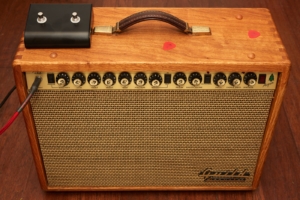
This amp is arguably worse. The controls are more baffling, there are LEDs that don’t make immediate sense, and some of the useful labels are under the top lip of the cabinet where you can’t see them.
I did most of my testing with a guitar on my knee sitting in front of the amp with a view similar to the one in the picture. If I got any closer to the amp then I couldn’t read the labels for the knobs, and you know when that happens? When you approach the amp to change the knobs.
Electronics
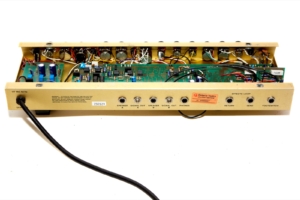
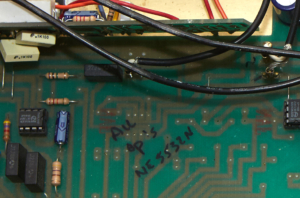
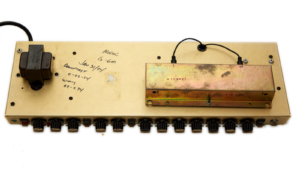
There is a bit more writing on the main board as well marking other chip part numbers and some minor notes. All of this writing on the board would normally make me think that some tech worked on it years after it was made, but the 1994 date on the chassis made me wonder if these are factory marks. Maybe even some sort of prototype or early build sample. Given the difficulty in finding details about this amp, I doubt I’d ever know for sure, though I have my doubts (read on).
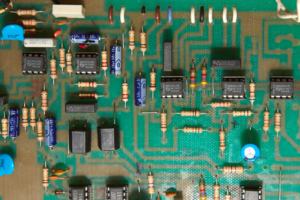
I will say that I think this amp sounds better than my G300 Tamarack, but it’s not really a fair comparison to begin with given the different speakers, cabinet, power, etc.
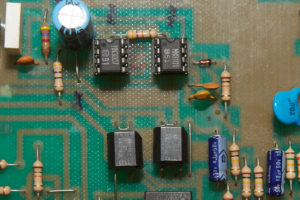
This amp does have an effects loop which is a nice step up from the G300 Tamarack. It also has dedicated speaker outs as well as a headphone out on the back. There is also a signal out jack for each of the stereo channels for low-level signal reamping which is a nice touch. Combined, these additions make for a much more useful amp more in-line with current offerings than the smaller and less expandable G300 Tamarack.
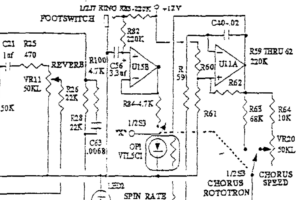
Speakers
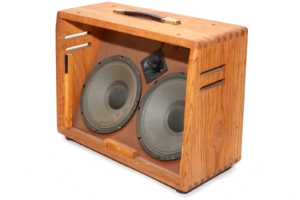
The woofers are marked 052-042 along with some Eminence codes with a couple of very worn stickers as follows:
10″ (R) – 10328 8Ω 67-93230795 G1
10″ (L) – 10328 8Ω 67-93230793 G1
Tweeter – No markings
The Eminence codes break down As follows:
10328 – Customer part number
8Ω – Speaker impedance
67-93230795 – Eminence
67-93230795 – Made in 1993
67-93230795 – made in the 23rd week
67-93230793 – The 793rd speaker made that week.
67-93230795 – The 795th speaker made that week.
G1 is an Eminence metal group number. I have no idea what that means but suspect is has to do with magnet types.
I emailed Eminence about these speakers and got this reply:
10328 was a custom designed OEM speaker that we manufactured to one of our customer’s specifications. It is an 8 ohm speaker with a 1.5″ voice coil and a 16 oz ceramic magnet. We do not rate OEM designs (that is left up to the customer to test and rate their cabinet or amp), but a conservative thermal power rating based on the voice coil diameter would be about 50 watts.
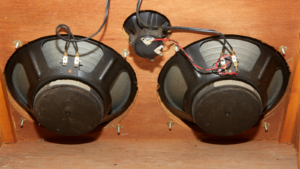
Since CTS then sold the product line in 2005 or so to Piezo Source, replacements can be bought from Piezo Source or US Speaker and the specs for the currently made unit are here. I have no idea if the new ones sound the same as the old ones.
The piezo horn is wired to left speaker and there is no crossover of any kind involved in the circuit. This was a common design at the time because these horns were advertised as not needing a crossover, though today many people insist that the behave better with one in the mix.
Sound
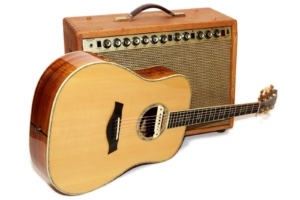
Of course, I made the recordings anyway. I dialed the amp in so that I liked the sound and then promptly didn’t write down what those settings were. Then I set about methodically going through the effects settings because somehow that warranted proper note-taking where the actual tone of the amp did not. I guess there are reasons why I’m not actually a scientist.
No effects
Chorus 5
Chorus 10
Reverb 5
Reverb 10
Rototron 5
Rototron 10
Chorus vs. Rototron
Chorus Hiss
The first recording is of the amp with no effects active. It is very easy to dial in a darker or brighter tone with this amp and with so many knobs it would take me a year to deliver a variety of tones, so I opted to keep everything simple. At least that’s what I’ve told myself, so let’s all pretend that this is a good thing.
The recordings are pretty obvious based on what I’ve named them, but according to my notes the Rototron on 10 also got the added adjective “nauseating”, and listening to it now I can see why.
It is very easy to make this amp sound terrible. Because of the piezo horn, dialing excessive highs can be downright painful and dialing out the highs excessively can make the amp sound woofy and dull, but there is also good tones in this amp if you avoid the extremes. The effects are similarly capable of awful sounds, but by keeping within tolerances I think the amp can sound pretty great. In fact, I really enjoyed playing the Artist Award through this amp a lot more than I did playing my much brighter-sounding Taylor, though the Artist Award is in a different league than my Taylor, and that’s saying something because I love my Taylor.
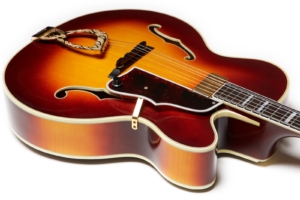
Conclusion
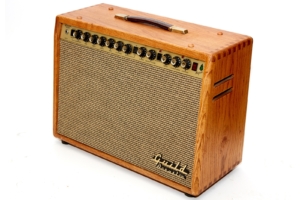
I don’t know that I’d choose this amp over a modern choice unless I wanted the warm look of the wooded cabinet for aesthetic reasons. I’ve gigged with my acoustic in the past using nothing more than my Axe-FX set on pass-thru (acting as an EQ) and my QSC K12 delivering the power and that worked quite well for me. Most acoustic players don’t haul around an Axe-FX rig, though.
The weakness of this amp is that a) I didn’t find any awe-inspiring tones, though to be fair an acoustic amp should deliver the tone of the guitar at volume, and b) the effects didn’t wow me largely due to the hiss that wouldn’t go away when they were engaged. I think the amp simply suffers from being a decades old design at this point. There’s nothing wrong with it, but modern amps can just do it better.
Where I think this amp shines is in a home office, studio, living room, or anywhere else that a tolex-covered amp wouldn’t work. This amp has style, and while it may not be my main choice on stage, it might be at home. The problem is that while I’m playing at home, I don’t need an acoustic amp. As a result it sits mostly unused. Sure looks nice, though.
Donate: PayPal Crypto:
ETH: 0x0AC57f8e0A49dc06Ed4f7926d169342ec4FCd461
Doge: DFWpLqMr6QF67t4wRzvTtNd8UDwjGTQBGs

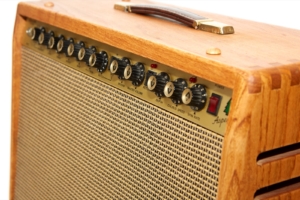
Hello, I enjoyed your blog on the Guild Aspen! Killer research, killer information.I have one that has just been professionally serviced and works perfectly. I have the foot switch and the cover. It is in extremely excellent shape. I would like to sell it. What do you think a fair price would be for me to ask? Also, I own a Tamarack that I purchased new in 1994. I still have the cover and the original owners manual. It is in minty condition. However, the tweeter/horn is intermittent, it goes in and out when being played through. So, your information on where I can get a replacement is a god send. Also,when I purchased the Tamarack brand new from the music store/Guild rep. it had wooden plugs on the top over the four screws! So does the Aspen! Anyway, Thank you for your great information. What do you think a fair price for the just serviced and extremely clean and in excellent shape Aspen should be?
Thanks! As for value, I’d probably say $350-600. Best way to see for yourself is Reverb completed sales: https://reverb.com/marketplace?query=guild%20aspen&show_only_sold=true
I would be interested in the amp if it’s for sale….